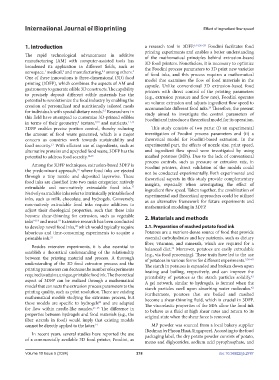Page 226 - IJB-10-5
P. 226
International Journal of Bioprinting Effect of ingredient flow speed
1. Introduction a research tool in 3DFP. 6,14,26–33 Foodini facilitates food
printing experiments and enables a better understanding
The rapid technological advancement in additive of the mathematical principles behind extrusion-based
manufacturing (AM) with computer-assisted tools has 3D food printers. Nonetheless, it is necessary to optimize
broadened its application in different fields, such as the Foodini process parameters to 3D print new varieties
aerospace, medical, and manufacturing, among others. of food inks, and this process requires a mathematical
3,4
5
2
1
One of these innovations is three-dimensional (3D) food model that examines the flow of food materials in the
printing (3DFP), which combines the aspects of AM and capsule. Unlike conventional 3D extrusion-based food
gastronomy to generate edible 3D constructs. The capability printers with direct control of the printing parameters
to precisely deposit different edible materials has the (e.g., extrusion pressure and flow rate), Foodini operates
potential to revolutionize the food industry by enabling the on volume extrusion and adjusts ingredient flow speed to
creation of personalized and nutritionally tailored meals accommodate different food inks. Therefore, the present
34
for individuals with special dietary needs. Researchers in study aimed to investigate the control parameters of
6,7
this field have attempted to customize 3D-printed edibles Foodini and introduce a theoretical model for its operation.
in terms of their geometry, texture, and nutrients. 11,12
9,10
8
3DFP enables precise portion control, thereby reducing This study consists of two parts: (i) an experimental
the amount of food waste generated, which is a major investigation of Foodini process parameters and (ii) a
concern as countries work towards sustainability and theoretical model for Foodini-based extrusion. In the
food security. With efficient use of ingredients, such as experimental part, the effects of nozzle size, print speed,
13
alternative proteins and upcycled food waste, 3DFP has the and ingredient flow speed were investigated by using
potential to address food scarcity. 14,15 mashed potatoes (MPs). Due to the lack of conventional
process controls, such as pressure or extrusion rate, in
Among the 3DFP techniques, extrusion-based 3DFP is Foodini printers, direct validation of the models could
the predominant approach, where food inks are ejected not be conducted experimentally. Both experimental and
16
through a tiny nozzle and deposited layerwise. These theoretical aspects in this study provide complementary
food inks are classified into two main categories: natively insights, especially when investigating the effect of
extrudable and non-natively extrudable food inks. ingredient flow speed. Taken together, the combination of
17
Natively extrudable inks refer to intrinsically printable food experimental and theoretical approaches could be utilized
inks, such as milk, chocolate, and hydrogels. Conversely, as an alternative framework for future experiments and
non-natively extrudable food inks require additives to mathematical modeling in 3DFP.
adjust their rheological properties, such that these inks
become shear-thinning for extrusion, such as vegetable 2. Materials and methods
inks 14,18 and meat. Extensive research has been conducted
19
to develop novel food inks, which would typically require 2.1. Preparation of mashed potato food ink
20
laborious and time-consuming experiments to acquire a Potatoes are a nutrient-dense source of food that provide
printable ink. 21 essential carbohydrates and key nutrients, such as dietary
fiber, vitamins, and minerals, which are required for a
Besides extensive experiments, it is also essential to 35
establish a theoretical understanding of the relationship balanced diet. Moreover, potatoes are easily extrudable
(e.g., via food processing). These traits have led to the use
between the printing material and process. A thorough of potatoes in various forms for different experiments. 9,36–40
understanding of the 3D food extrusion process and the The starch in potatoes is expanded and broken down upon
printing parameters can decrease the number of experiments heating and boiling, respectively, and can improve the
required to attain a unique, printable food ink. The theoretical printability of potatoes as the starch particles solidify.
41
aspect of 3DFP can be realized through a mathematical A gel network, similar to hydrogels, is formed when the
model that connects the extrusion process parameters to the starch particles swell upon absorbing water molecules.
42
printing quality, such as print resolution. There are existing Furthermore, potatoes that are boiled and mashed
mathematical models studying the extrusion process, but become a shear-thinning fluid, which is crucial in 3DFP.
these models are specific to hydrogels and are adapted The viscoelastic properties of the MPs allow the food ink
22
for flow within needle-like nozzles. 23–25 The difference in to behave as a fluid at high shear rates and return to its
properties between hydrogels and food materials (e.g., the original state when the shear force is removed.
fiber strands in food) would imply that existing models
cannot be directly applied to the latter. 14 MP powder was sourced from a local bakery supplier
(Redman by Phoon Huat, Singapore). According to the food
In recent years, several studies have reported the use packaging label, the dry potato powder consists of potato,
of a commercially available 3D food printer, Foodini, as mono and diglycerides, sodium acid pyrophosphate, and
Volume 10 Issue 5 (2024) 218 doi: 10.36922/ijb.2787

